
MAY CONTAIN NUTS

Search Shorpy
SHORPY ART

Framed or unframed, desk size to sofa size, printed by us in Arizona and Alabama since 2007. Explore now.
Join and Share
Ad-Free Shorpy
Shorpy is funded by you. Patreon contributors get an ad-free experience.
Learn more.

Recent comments
- Baldwin 62303
- Baldwin VO-1000
- Cold
- No expense spared
- Tough Guys
- Lost in Toyland
- And without gloves
- If I were a blindfolded time traveler
- Smoke Consumer Also Cooks
- Oh that stove!
- Possibly still there?
- What?!?
- $100 Reward
- Freeze Frame
- Texas Flyer wanted
- Just a Year Too Soon
- WWII -- Replacing men with women at the railroad crossing.
- Yes, Icing
- You kids drive me nuts!
- NOT An Easy Job
- I wonder
- Just add window boxes
- Icing Platform?
- Indiana Harbor Belt abides
- Freezing haze
- Corrections (for those who care)
- C&NW at Nelson
- Fallen Flags
- A dangerous job made worse
- Water Stop
Member Photos
The Shorpy
Print Emporium
Print Emporium
Search Shorpy
Search results -- 30 results per page
- 302 Mott Street: 1911
- ... while the children eventually married and mostly moved to Long Island.
The family lived at 213 Mott Street in 1905 and 105 Thomson ... Posted by Dave - 09/09/2011 - 10:29am -
![302 Mott Street: 1911 December 1911. Family of Mrs. Mette making flowers in a very dirty tenement, 302 Mott Street, top floor. Josephine, 13, helps outside school hours until 9 P.M. sometimes. She is soon to be 14 and expects to go to work in an embroidery factory. Says she worked in that factory all last summer. Nicholas, 6 years old and Johnnie, 8 yrs. The old work some. All together earn only 40 to 50 cents a day. Baby (20 months old) plays with the flowers, and they expect he can help a little before long. The father drives a coach (or hack) irregularly. View full size. Photo and caption by Lewis Wickes Hine.
DirtRobert,
You need to click on the full size option.
The floor is dirty, the door has small child "art", the table cloth is dirty and has numerous holes.
I'm sure they are doing their best under who knows what type of circumstances.
Where's the dirtThe notes state, "a very dirty tenement." There are some things like a wash-tub and a scrubbing-board that are in plain view. Maybe those thing cold have been stowed a bit better. But the wall cabinets have lites you can see the shelves inside and the insides seem to be in order. The floor is clean. The women's clothing seems to be quite nice. Those boys look fine with their jackets and even a scarf on one. The only thing that shows something a bit out of order is the dark blotches on the oil cloth. Most likely holes. The house keeping looks great to me.
Making flowersI've seen other flower photos here... who do they make the flowers for and what are they used for? Hats maybe? Also, are they real or silk? Must be fake right?
[Probably made for clothing manufacturers in the garment district. I'm not sure how they made artificial flowers back then. Although we do have some photos of real roses being dipped in white wax. - Dave]
Dirt If you look at the wall by the mirror you can see the "dirt" on the wall. My guess is that it is from smoke from a cook stove or coal heater. People used to scrub down their walls every spring to remove the grime accumulated from a winter of heating and cooking. I guess the comment of "very dirty" spoke to the grime on the walls as much as anything else.
Actually if you look at the table and other furniture in the room they seem pretty ornate. A family fallen on hard times? Dragging once nice stuff from place to place, each place a little more worse for wear than the last.
Not DirtyPoverty is not the same as being dirty. The linoleum on that floor may be a wreck from being where one enters the house. Perhaps they don't have the money to go out and replace it. The baby's high chair may also be putting black marks on the floor as it gets dragged around. They also might have to haul some coal upstairs for the stove.
These folks lived in a world of maybe 10 people in an apartment the size of the average kids bedroom these days. They are so poor that the entire family including kids is working to keep their heads above water financially. These weren't the days of handi-wipes and swiffers and vacuum cleaners and kids laying around all day playing on their computers and listening to their ipods.
BTW, the kids clothes all look very clean. Any mess on a baby is because it's a baby. There's no washer and dryer sitting nearby to pop the kid's jammies in every time they get a little mess on them.
If you're ever in New York, you can get an eye opening introduction to how how immigrants to America lived down on "the lower east side" by going to this museum. I've been there. Take the tour of a real tenement which was purchased and "saved for historical/educational purposes.
http://www.tenement.org/
Go read the works of Jacob Riis and look at his photos. It's a testament to the human spirit that these people left their homelands to come to a new country to try to get a better life for themselves and their kids. This is the story behind Ellis Island and the Statue of Liberty. It's the story behind the American dream.
http://en.wikipedia.org/wiki/Jacob_Riis
Dismissing things as dirty misses the point.
Thanks for sharing the photo, however. It's appeciated.
[The captions describing these photos are by photographer Lewis Hine, written around 100 years ago. "Dirty" is his description, not ours. - Dave]
Re: Not DirtySomething we mention every now and then: The captions describing these tenement photos were written by photographer Lewis Hine almost 100 years ago. "Dirty" is his description. It helps to remember that he is trying to paint a bleak picture for his audience -- the U.S. Congress -- in his organization's effort to end the practice of child labor.
StagingSomething to remember about Hine's photos is that they are not "candid" photos. At this period of time, taking a photo like this required a big heavy camera on a tripod, and a flash powder apparatus. Probably the table had to be moved back toward the wall and sink to "get it all in." Since it is a "staged" photo, I'm sure Hine controlled what was in the photo to get his story across.
[That would be posed, not "staged." Big difference. - Dave]
Dirty TenementsThis is Joe Manning, of the Lewis Hine Project. Hine had a habit of commenting about the cleanliness and neatness of his subject's houses or apartments. I suspect that it might have just been a value judgment based on his own preferences. Perhaps he was very fastidious, maybe picking that up from his mother when he was growing up in Wisconsin. We can't assume that he was just trying to exaggerate for effect. I did research on a woman who was photographed in her house in Leeds, Mass. She was putting bristles on toothbrushes. Hine's caption, in part, says, "putting bristles into tooth brushes in an untidy kitchen." I interviewed the woman's granddaughter, who had never seen the photo. When she saw the caption, she said, "Untidy kitchen? Gramma was spotless. You could eat off her floor."
Point Taken DaveGood point, Dave. Thanks for clarifying that.
[One of my many pet peeves. I could start a zoo! - Dave]
Dirty? Untidy?Thanks for the great insight, Joe. It sounds like Mr. Hine had a few quirks of his own. Don't we all?
BeautyThey may be poor but they do have a gorgeous opalescent vase standing on the shelf in the upper right hand corner.
I lived there302 Mott Street, 5th floor. Small apt, typical for NYC. great location. Miss the city.
EurekaMrs. Mette was Maria Auletta/Avoletti Motta, who lived with her husband Joseph and eventually with their nine children born between 1896 and 1920. By the time this photo was taken Maria and Joseph were naturalized American citizens who had spent most of their lives in the US (after being born in Italy). Oldest daughter Lucy is not picture or mentioned in the caption. Baby was Daniel, born in 1910.
Joseph died in 1919 at the age of about 50, while the children eventually married and mostly moved to Long Island.
The family lived at 213 Mott Street in 1905 and 105 Thomson Street in 1915 (no 1910 listing).
(The Gallery, Kids, Lewis Hine, NYC)](https://www.shorpy.com/files/images/05481u.thumbnail.jpg)
- Sidewheeler: 1910
- ... in winter, 1906. [From "Steel Rails to the Sunrise, The Long Island Rail Road" by Ron Zeil and George Foster]
Schooner Rig The ... run and in 1903 sold to the Montauk Steamboat Company for Long Island service, receiving the name Greenport, one of its stops. Its time ... Posted by Dave - 07/31/2015 - 1:08pm -
![Sidewheeler: 1910 Circa 1910. "Steamer Greenport at Manhanset House landing, Shelter Island, N.Y." 8x10 inch glass negative, Detroit Publishing Company. View full size.
About Greenport Montauk Steamboat Co. purchased "Sagadahoc" at Bath, Maine in 1903 and renamed her "Greenport." She was built as "Star of the East" by John Englis in New York in 1866 but was modernized a few years before the M.S. purchase.
Placed on the Block Island run, she was slow and expensive for the work, so was sold in winter, 1906. [From "Steel Rails to the Sunrise, The Long Island Rail Road" by Ron Zeil and George Foster]
Schooner RigThe Greenport has sails bent to her gaffs, ready for instant use if the engine fails. Her masts have no booms, only gaffs; her sails will be set "flying".
The diamond shaped device on the top deck is the "walking beam" of her single-cylinder steam engine.
If you look closely, there's an oil lantern hung on one of the stays of the mizzen (rear) mast.
The area of the pier with the white picket fences is a small vehicular ferry slip. At this date, most of the vehicles on the ferry will be horse-drawn.
There's an array of cargo laid out on the pier by the gangway. I can't make out what it might be. Can anyone identify it? It's probably outgoing agricultural produce.
[Those are logs. - Dave]
The GreenportThe Greenport began life as the Star of the East, built 1866 by John Inglis & Company at New York for the Kennebec Steamboat Company, to run between Kennebec and Boston. 244.2' x 35.2' x 12.8,' 1413 gross tons. It was powered by a vertical beam engine, 56" x 11,' built by the Morgan Iron Works. In 1891 it became the Sagadahoc and was placed on the Boston-Bangor run and in 1903 sold to the Montauk Steamboat Company for Long Island service, receiving the name Greenport, one of its stops. Its time in this service is undoubtedly depicted in the photograph.
Greenport was withdrawn from service in 1909 and used as a spare boat for the Hudson Navigation Company, but spent virtually all its time laid up at Newburgh until resurrected in 1914 and briefly placed on the Albany-New York City run on the Hudson. That resurrection was short-lived, and in 1916 the vessel was converted to a coal barge for use at Connecticut, but was soon back at New York, where the hull was abandoned at 215th Street on the Harlem River, about where the Harlem River turns west towards the Hudson.
(The Gallery, Boats & Bridges, DPC)](https://www.shorpy.com/files/images/SHORPY-4a17227a.thumbnail.jpg)
- City Gas: 1905
- ... Those Elmurst, NY, Gas Tanks were a staple for many Long Island Expressway Commuters. Traffic reporters would announce, with almost ... Posted by Dave - 10/01/2019 - 11:14am -
![City Gas: 1905 Circa 1905. "Gas holder, Detroit City Gas Company." A familiar sight from the era of "city gas," when municipalities had their own gas plants in the days before long-distance transmission of natural gas. The telescoping sections rose or fell as "illuminating gas," which was made by heating coal, was put into or removed from the holder. 8x10 glass negative. View full size.
Gas Holder Fun FactsAs my 1911 Encyclopedia Britannica states, "A gasworks should be sited with some care as it does not improve the neighborhood." Water was kept between the telescoping sections as a seal -- the internal pressure was not that great. Cincinnati, a town which has creatively repurposed its older infrastructure, has a gasworks park with creative "sculptures" made from the old apparatus.
Oval GasGasometers are still a feature of some British city skylines, one of the most high-profile being in the background of the Oval cricket ground in South London.
WiredI am mesmerized by those wires coming in from the upper right. I suppose they run behind the container and that it's only their shadow that continues perfectly across the front until diverted by the curve - but, as I study them, they play tricks on my brain jumping from foreground to background amongst the geometric shadows.
[The wires run across the photo in front of the tank. - Dave]
So THAT's what that thing was!There was a framework that looked like this to the west of I-435 in Kansas City on the river bluffs - I wondered for years what it was. Thanks for clearing up that mystery!
Ka-BOOMGot a light.
West coast gasWhen I was growing up out here in California these things were a familiar sight in just about any city of a goodly size, even suburban San Rafael just to the north of us in Marin County. There was an enormous one in San Francisco up through the mid-1960s, at the east end of the Marina District. Here it is at the right in a section of a slide I took from across the bay near Sausalito in early 1965.
Gas Tank ParkNew York had dozens of these structures. Some of the most famous were the Elmhurst tanks. They were knocked down in the 1980s and now the site of Gas Tank Park. Near most of these structures were the gashouses which produced the illuminating gas -- sites often requiring remediation to remove the contaminant plumes of benzene and other aromatic hydrocarbons which dripped into the ground.
Got gas?Hi tterrace. That tank is now the site of the upscale Marina Safeway. However, its memory lives on in the name of the sailboat marina right across the street: Gas House Cove.
Worried ?Wonder if the people living next door ever worried about an explosion. That being said, I have never heard of one blowing up. Gas lines, yes. The neighbors most likely never had low pressure in their lines, at least.
A while back I was looking at some of these in Europe and UK online; some gas holders overseas have been converted to condominiums or apartment buildings!
"Gasometers"I live in London, and you will still see these structures all over England and particularly in the large cities. We call them "Gasometers," and they are still part of the national grid for gas distribution.
Love em in London!These things seem to inspire the same fond feelings as water towers. So big and matter of fact and useful! The number 8 gasometer down the road from me in King's Cross, London, is being zhuzhed up as part of the regeneration of the area. Hopefully they'll keep it a little bit weird and rusty.
http://www.bp-k.com/projects/Gasholder.html
An Illuminating Subject.When I was young, not far from our home was a coking plant which had two huge gas holders of the type shown.
They would slowly rise as gas was produced and fall as gas consumption exceeded supply.
The adjacent gas works would emit an atomic cloud of steam as a coke oven was "pushed" and the glowing coke quenched by water before it was loaded into steel hopper cars.
On occasion a wood-sided hopper was used, the coke not completely quenched, and the resulting fire caused by the wind of the train's motion would burn thru the car side and a glowing lava of coke pour out as the train moved down the track.
Steel coke cars would sometimes glow in patches at night.
I do not know if there are any gas holders of this design left.
I would like to ride on top of one and watch it inch up by looking at the framework, and see it pause as the pressure inside had to increase to lift the next section.
I tell younger people about them and they do not grasp the idea of the telescoping sections at all, how the pressure inside, although low, was enough to lift the tons of metal the tanks sections were made of.
Other gas holders were circular and made with bricks, not rising nor falling.
The whole coke plant and the gas holders are long gone, ugly to be sure, being replaced with even UGLIER slumplexes of high-density housing.
LandmarksThose Elmurst, NY, Gas Tanks were a staple for many Long Island Expressway Commuters. Traffic reporters would announce, with almost every daily (weekday) morning drive heading to The Queens-Midtown Tunnel, that the major tie-ups would be in the vicinity of the gas tanks. Incidentally, the tanks themselves rose and fell according the volume of gas in them.
They could have preserved itby turning it into a park, like we did here in Seattle.
Same in St. LouisThere was at least one of these on highway 64/40 in St. Louis that I used to pass daily on my commute. It would rise and fall and I always wondered what it was. I'd heard it was for natural gas but I never really understood, but now I do. Great photo- thanks for posting!
http://www.builtstlouis.net/industrial/gasometers.html
Roll up the windows! We passed two of these tanks en route to Grand-ma's Brownstone in Brooklyn, NY. But the associated cracking plants and their gas flare towers sent the pervasive stench of rotten eggs drifting over the county for miles around. We all held our noses and made rude noises until shushed by the adults.
Wow, popular topic! I just wanted to add that modern tanks act as flow buffers, just like water towers. Instead of just storing locally made gas, they store a 'back-up' quantity of product to handle periods of high demand, but are fed by massive pipelines from distant plants.
(The Gallery, Detroit Photos, DPC)](https://www.shorpy.com/files/images/4a20632a.thumbnail.jpg)
- Back From Cuba: 1898
- Long Island, New York, circa 1898. "Boys of the 71st N.Y. at Montauk Point ... event in New York City. The were sent home on a special Long Island Railroad train after some weeks.
A similar group picture with ... Posted by Dave - 04/02/2013 - 9:36am -
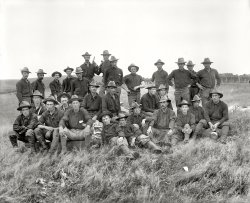
- Manhattan: 1908
- ... Post Foods, was at the end, a division of Kraft Food. The Long Island University Nassau County Campus, C.W. Post College, is named in his ... Posted by Dave - 07/18/2012 - 3:35pm -
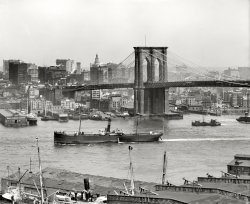
- Going Up: 1900
- ... which stretched from lower Manhattan to Sandy and out on Long Island. This tower was probably on a newspaper building on Park/Newspaper ... Posted by Dave - 08/13/2012 - 7:57pm -
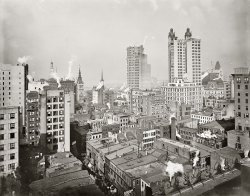
- Dynaflow Diplomacy: 1949
- ... headquarters at the Sperry Gyroscope industrial park on Long Island, along with its fleet of black Buick Super sedans. 35mm Kodachrome ... Posted by Dave - 07/28/2022 - 9:41pm -
![Dynaflow Diplomacy: 1949 Circa 1949. "United Nations, Lake Success, New York." The organization's temporary headquarters at the Sperry Gyroscope industrial park on Long Island, along with its fleet of black Buick Super sedans. 35mm Kodachrome transparency. View full size.
StellarThis building is now the headquarters for Hain Celestial
I believe that's my car you're inIn the movies, you can tell which black sedan belongs to which foreign minister by the little flags mounted over the headlights. Without the flags, how did the chauffeurs tell these cars apart? I know I'm not the only one who's ever walked up to the wrong car in a parking lot. But I was never on the verge of creating an international incident.
No Dynaflows here [oops]In 1949, Supers equipped with the second year availability of its new automatic transmission had the word "Dynaflow" in script above the bright trim at the end of the rear quarter panels and also on each side of the trunk release.
[All of these cars have a "Dynaflow" script on the rear fender. - Dave]
(The Gallery, Kodachromes, Cars, Trucks, Buses)](https://www.shorpy.com/files/images/SHORPY-P-0105.thumbnail.jpg)
- Fifth Avenue: 1908
- ... was relocated to a still existing Vanderbilt house on Long Island.
(The Gallery, NYC) ... Posted by Dave - 08/09/2012 - 3:20pm -
![Fifth Avenue: 1908 New York circa 1908. "Fifth Avenue hotels north from 51st Street." 8x10 inch dry plate glass negative, Detroit Publishing Company. View full size.
Ivy-covered walls at 51st and Fifth!That's Central Park up ahead, where the Plaza Hotel and Apple's all-night store now stand face to face.
It looked so much nicer a century ago.
That vehicle in the centerlooks like an armored car.
[It's an electric taxicab. - Dave]
+98Below is the same view from April of 2006.
1906 Fifth Avenue PostcardThis postcard in my family collection shows a similar, but earlier view of Fifth Avenue.
GrandeurIt just looks to me as though life was so much richer and dignified then. I think a nation's architecture speaks a lot about the mindset of the people.
That churchAny one know which church that is on the left. At first I thought it was St. Patrick's but St. Pats is behind to the right.
A high point in Central ParkIf you look in the distance at Central Park, it looks like there is a small mountain there. Was there a hill that was excavated in the forming of the park?
Vanderbilt RowIn the foreground on the left is the Vanderbilt double mansion built by William H. Vanderbilt at 640 Fifth Avenue for himself and two daughters. In 1908, Henry Clay Frick was in his third year of living there at a reported annual rental of $50,000. http://nyarc.org/content/vanderbilt%E2%80%99s-house-dreams
You can see the surviving half of the house in 1933 surrounded by much taller neighbors in this classic Shorpy photo, next to what will become Rockefeller Center. https://www.shorpy.com/30-Rock It finally bit the dust in 1947.
And right across 52d Street is the celebrated home of his second son William K Vanderbilt, which made it to the 1920s.
So sad, bye byeI'm always a little shocked and saddened by the changes made by "progress" but this all really takes the cake. Everything appears to be gone and it all looked beautiful to my untrained eye. I've noticed that whenever I see cupolas or turrets in an old photo, you can almost bet that building will be gone. Speaking of which, my favorite building, the one just to the left with the very pointed peak, has two interesting items that I don't quite understand. One, the windows all look open, but way too "open" for this construction if you get my drift. And two, whats with the guy on the chimney?
Houses of the VanderbiltsOn the left side of the avenue, we can see several houses belonging to the Vanderbilt family: First is a part of the double house (actually 3 houses) covering the whole block between 51st and 52nd Streets, built for William Henry Vanderbilt (son of the Commodore) and his two married daughters. These houses were designed by the decorating firm of Herter Brothers and built between 1879 and 1882. Next, at the northwest corner of 52nd Street, is the house designed by Richard Morris Hunt for William K. Vanderbilt (one of the Commodore's grandsons) and built in 1879-1882. This landmark of old New York was also known as the "Petit Chateau." I'm fairly certain that the smaller house right next to it was also built for a Vanderbilt, but I can't remember which one (!) The very last building visible on this side of the street, between 57th and 58th Streets, would be the Cornelius Vanderbilt II House, designed by George B. Post for another grandson of the Commodore. This last house was built in two phases, the first in 1881-1882 and the second in 1892-1894.
Flue with a view Please tell me that that's a brave sweep taking in the view on his lunch break, and not a boring piece of statuary (to the left of the very Cinderella-looking turret)!
Re: That churchThat's the Fifth Avenue Presbyterian Church http://www.fapc.org/our-church/history which still stands at 55th Street.
St. Thomas Church at 53rdThere are actually two churches visible on the left side of Fifth Avenue - the first of which is the tower of St. Thomas Episcopal Church, at the northwest corner of Fifth Avenue and 53rd Street. The Church burned in early August 1905, but the tower reportedly survived. From this angle, in fact, it's difficult to see any fire damage; the facade of the front door of the church seems intact.
Between 1907 and 1909, the City widened Fifth Avenue between 23rd and 47th Streets, by taking 7 1/2 feet from sidewalks on each side, but by July 1909 that project had not yet reached further north, to this area.
660 Fifth AvenueThe French Chateauesque mansion second block on the left is the William K. Vanderbilt house, designed by Richard Morris Hunt. I seem to remember from an episode of A&E's America's Castles that the statue was relocated to a still existing Vanderbilt house on Long Island.
(The Gallery, NYC)](https://www.shorpy.com/files/images/SHORPY_4a22984a.thumbnail.jpg)
- Ford Target Computor: 1922
- ... himself?
Hannibal Ford The Ford Instrument Company, Long Island City, NY, was formed by Hannibal Ford in 1915. It built analog fire ... Posted by Dave - 09/13/2011 - 12:38pm -
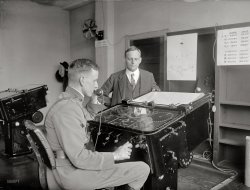
- Margaret Severn: 1923
- July 16, 1923. Long Island, New York. "Severn, Margaret, Miss." The dancer Margaret Severn ... Posted by Dave - 11/03/2021 - 2:29pm -
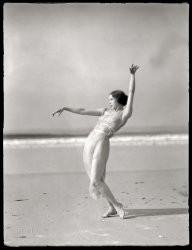
- Keg Run: 1943
- ... sold exclusively by the John Water DeSoto Dealership in Long Island City in the Borough of Queens. A story that I heard many years ago ... Posted by Dave - 03/08/2013 - 1:31pm -
![Keg Run: 1943 March 1943. "Beer truck on 44th 39th Street and Sixth Avenue." Just turn right at the Sandwich Shanty. Another truck shot by John Vachon. View full size.
Labor Stage, or Princess TheaterThe caption says 44th St, but the street sign on the left says 39th, home of the Labor Stage.
[Caption amended, 70 years after the fact. Better late than never! - Dave]
Roll out the barrelHaving spent my first 22 years in the northeast and being a Polish child in the 1940s & 50's, Sundays were the day that we were forced to listen to polkas on the radio from after church in the morning until about 2 or 3 in the afternoon, (and yes, we did have roast chicken most Sundays-I can even smell it now). I remember particularly the Victor and Sophie Zambroski show in Ct. that went on for hours and they must have played every polka ever written although they all sounded alike to me. Anyhoo, the exposure made us use our imagination (as radio people did) as they all had lyrics in English and so in our minds it was like our own individual mental "hit parade" envisioning how each song would be acted out. The beer barrel polka reminded me of a massive Polish party with the men rolling out ongoing parades of beer kegs, ladies dancing polkas together (since the men did not) and kids just having a riotous good time being crazy and eating themselves to regurgitation. In this picture, with the loosely-packed beer barrels, if those top rows started rolling off, the people getting hit with them would not find it at all enjoyable as I had imagined. Therefore this picture, once and for all, tells me I should re-imagine my childhood fantasies since rolling out barrels may have serious consequences. Sorry to ramble so much, it is a slow day.
Traffic JamThen and now. A few of the original buildings have survived.
Traffic patternsUnlike the time of the photo, W 39th Street is now only a left turn from 6th Ave which hasn't carried 2-way traffic in decades. The site of the two shorter buildings is now a Residence Inn. The next 2 buildings down 39th are still there.
That taxilooks like the famous yellow cab that was in many many movies and ended up at the U.S. pavilion in Montreal at EXPO 67. Movie buffs will have seen that cab in many movies from the 1940's to the 1950's, where is it now?
Trommer'sA little bit of history:
http://www.rustycans.com/COM/month0405.html
Wartime CounterespionageThe caption could have been intentionally misidentified to help protect the nation's wartime supply of Trommer's Beer & Ale.
Trommers of BrooklynTrommers Brewery was just outside the gates of Evergreen Cemetery in Brooklyn. (They had a second brewery in Orange NJ)
Famous for their all malt beer, (no corn sugar used in the conditioning.) They would be the vicitms of the brewery strike of 1949, when their chemists were locked out of the brewery and their yeast strain died. It was said to never taste the same again.
Wooden barrels in 1943, steel kegs came in after prohibition, but if they used steel, they were sent to the scrap metal drives for the war effort, although they may not have made the change yet. (Rheingold in Brooklyn was using wood kegs in '43.) There was such a shortage of beer kegs after prohibition that beer was imported from Germany, and the kegs were part of the deal.
There's a new Marriott Hotel on that far corner now.
Not since 1957Like most odd numbered Manhattan streets, 39th is one-way westbound. As far as I know it's always been that way. The beer truck therefore must be heading southbound on Sixth Avenue, which would have become impossible 14 years after the picture's date when Sixth Avenue became one-way northbound.
The building with the mansard roof on the corner of Sixth and 39th is gone now, as is the building next to it with the Labor Stage sign; the Marriott Residence Inn now occupies the site. The building across 39th housing the Sandwich Shanty also is history. Still around, however, are the two buildings on 39th to the right of the Labor Stage building. The first one is 108 W. 39th, built in 1928, while the second, lighter-colored one is part of a much larger building with the address of 1400 Broadway.
Two other vehicles from the good old days . . .Taxicab looks to be a Dodge (or at least a Chrysler product) of early 40's vintage with skylight - likely with leather upholstery as required by the City of New York for ease of clean-up. In front of the taxi appears to be a coal delivery truck, my guess a Mack AC Bulldog with chain drive - that chassis saw service during WWI. I was born that year, and all those vehicles were still in service well into the 1950's.
When Cabs had Legroom!Back when taxis had rear legroom to spare! There are probably even a couple of jump seats in that Chrysler taxicab.
Calling That CabI agree that the taxi is a Chrysler product, specifically a 1941 DeSoto, both per the design of the taillights and the front trim, as well as the fact that DeSotos were THE most popular make for American big-city taxicabs in the 1940s. Their Chrysler, Dodge, and even Plymouth siblings were very similar mechanically and in body style at the time, but DeSoto got the nod from the cab companies the most often. Watch for the preponderance of DeSoto taxis in photos and movies from the 1940's.
Trommer's Evergreen BreweryTrommer's advertisements from 1915, 1913 and 1909.
Oh, the history ..."I remember particularly the Victor and Sophie Zambroski show in Ct. that went on for hours"
Victor Zembruski and his teenaged bride Sophie started "Polka Time" (later renamed the "Polish Eagle Show") on WATR 1320-AM in Waterbury, Connecticut all the way back in 1934. Victor became ill and retired in the late 1960's, but Sophie carried on as sole host. Sophie herself retired, and handed the show over to her and Victor's daughter ... in 2008. That is not a mistake. Sophie hosted the same radio show for SIXTY FOUR years. She died in 2010, aged 92.
The Bronx Is Up And The Battery's DownIt's hard to tell, but I believe the cab is a DeSoto Skyview. Betty Garrett drove one in the movie "On The Town" with Gene Kelly and Frank Sinatra. These taxis had a moonroof that opened allowed the passengers to see the NYC skyline. They were sold exclusively by the John Water DeSoto Dealership in Long Island City in the Borough of Queens. A story that I heard many years ago that Water was Walter Chrysler's Son-In-Law but could never confirm it.
Coal truckThats a coal truck in front of the Chrysler taxi. I grew up in Great Neck NY and the apartment building in which we lived was heated by a coal fired furnace. The delivery man would put the coal chute through a basement window, then the super had to move the coal to the furnace which was on the other side of the building one wheel barrow at a time. I look back at that and realize he must have spent most of his time feeding that furnace, and that must be why he smelled like coal!
Thank you PeterMy heartfelt appreciation goes out to commenter Peter who added to "the rest of the story" with his update on the Zembruski family in Ct. I never dreamed they were still on the air there and that Sophie worked on the radio until 2008, when she was 90. It is so good to know that a familiar childhood radio show and family name are still playing that happy music as they did 69 years ago. That is quite a remarkable eye-opener and I had no idea it still exists, even now, when almost everything else about my childhood has become extinct, obsolete and long-gone. Thanks again Peter.
Re: DeSotoI am glad to defer to the posters who identified the taxi as a DeSoto, and also thanx to Mr Mel for indentifying the dealership that sold them. As for the coal delivery truck, our house in East New York in Brooklyn took coal directly to a coal bin within shoveling distance of the furnace - this continued until the conversion to oil late 40's/early 50's. This is a great site, especially for the camaraderie among the posters, and Dave and tterrace, as well!
Trucks & CabsThe Trommer's truck is a 1936 or early series 1937 Federal. There appears to be a lantern or some other object between the left front fender and the side of the hood. It looks like the truck body has an access hatch to the bed so (un)loading could take place or a ramp could be attached. If this door is used for unloading, it could be a pretty dangerous way to remove kegs that could roll easily.
The truck number by the door looks like number 346, but the back of the truck shows this is be truck 187.
The cab is a 1941 DeSoto SkyView, probably a model S-8, modified by Mr. Waters. Printed on and above the passenger door the words "DeSoto SkyView." It looks like there is a NY city cab/hack medallion attached in front of the front passenger side door.
Unfortunately Mr. Waters drowned in his pool in May 1941. Ironically a short biography of him was featured in the April 7, 1941 issue of Time Magazine.
Here is an excellent article and photos of Waters' automobiles.
+71Below is the same view from September of 2014.
(The Gallery, Cars, Trucks, Buses, John Vachon, NYC)](https://www.shorpy.com/files/images/SHORPY_8d26821a.thumbnail.jpg)
- Jamaica Avenue El: 1944
- ... was fought right there in Brooklyn (called the Battle of Long Island IIRC). Whodathunkit?
Just a few blocks west of the photo is Jamaica Station, the main hub of the Long Island Rail Road. Due south a few miles is JFK Airport, of which Shorpy ... Posted by Dave - 02/06/2013 - 5:40pm -
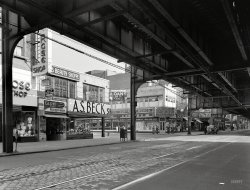
- Roundhouse: 1943
- ... Back 'er right in! I work in a roundhouse on the Long Island R.R. We bring the diesels in either way, depending on the work ... Posted by Dave - 09/09/2009 - 10:42pm -
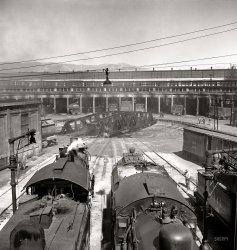
- Darken My Door: 1943
- ... the War, but the house we moved into on New York's Long island in the late 40s had opaque dark green roller-type window shades ... years old, I remember very well the blackouts we had on Long Island. The roll-up shades on the windows were a very dark and opaque ... Posted by Dave - 11/04/2013 - 5:27pm -
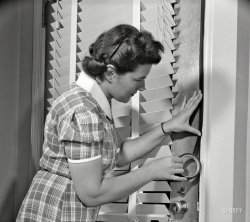
- Iron Horse: 1923
- ... 'round! I work at the Morris Park facility of the Long Island RR. The place dates to the late 1800's and yes we still have a ... Posted by Dave - 07/31/2012 - 2:56pm -
![Iron Horse: 1923 Washington, D.C., circa 1923. "Bethlehem Steel -- Washington Terminal Co." National Photo Company Collection glass negative. View full size.
USRA switcherThis is a USRA (United States Railroad Administration) standard design from World War I. Still available as a model.
Really CleanDid they give the turntable operators shack a coat of paint just for this photo? The gravel area in the foreground looks to have been groomed for the photo too. In today's world I would expect to see a lot of clutter and trash.
[It looks fresh because it's new. - Dave]
Word ChoicesWhat's an "iron" horse doing in a steelyard?
[The yard is Union Station in Washington. - Dave]
Dressed for the job!Love how the fireman is dressed with overalls and and a bowtie! People took their jobs seriously back then.
Spot the signExcellent venue to advertise Coca-Cola!
Spinning on the big wheelLove the train photos - thanks Dave. Did a little looking around - this is probably one of 255 0-6-0 switcher locomotives built to USRA specifications starting in 1916. Washington Terminal received three. The man in the loco driving seat is most likely not the engineer, but the hostler who moved locomotives at roundhouse turntables.
Looks like a roundhouseDo railroads still use those? Can't say as I've ever seen one.
[A roundhouse is a building. This is a turntable -- what would be in a roundhouse. - Dave]
Ah! I have a turntable in the entertainment room but I can't fit a steam engine on it. It only plays records. Anyone remember what a 'record' is?
Bethlehem is the brandThis is obviously a shiny, new turntable; it doesn't show any dirt, let alone grease or rust.The pit looks like newly-cured concrete. WT's number 34 may well be the first hog to ride this table.
This table is electric powered; note the power source above the center of the bridge. The mechanism is under the operator's cabin.
Washington Terminal has had at least two turntables in modern times, and I'm trying to figure out which this is. One was located at Ivy City, site of WT's engine facility; the second is almost under the station trainshed. I'm betting this is the latter, though it looks quite different without the former Railroad Express building which would be along the background today.
Oh, this is likely a Bethlehem Steel turntable, and Washington Terminal is today operated by Amtrak.
[Washington Terminal was the company that owned and operated Union Station. Bethlehem Steel was the client that commissioned the photo. - Dave]
Put them on the pitTurntables have long been a thing of the past, as is the routine need to turn an engine. As a practical matter, steam locomotives usually only ran nose first, which frequently required a locomotive to be "turned" before being sent down the main. (An exception was the B & O practice of running their locomotives backward through tunnels out east, to spare the head-end crew the effects of breathing trapped engine smoke.) Most power consists today have engines on each end facing opposite directions, so no matter what the assignment, a controlling engine will be "first out," pointed forward. In the rare event a engine needs to be turned, they're usually passed through a wye.
Not insideDave, the turntable wouldn't be inside the roundhouse. Picture a roundhouse as part of a circle (an arc at the perimeter of a circle). The turntable would be located at the center point of the circle.
[In other words, "in the roundhouse." The same way football players play "in a stadium." The roundhouse includes the turntable, which can be covered or not. - Dave]
Washington Terminal OperationsI would guess this photo was taken at the Ivy City yards looking eastward. The rise in the background could either be Brentwood or Mt. Olivet. Dave, not all turntables were located inside roundhouses. Often the roundhouse circled around the turntable but the turntable itself was not covered. An example is the still-functioning roundhouse and turntable at the Steamtown National Historic Site, Scranton Pa.
[The turntable is in the roundhouse. The roundhouse goes around the turntable. Moving right along. - Dave]
Was this a turntable solely for "heading" engines or is the photo taken after the first stage of a construction project which would see a new roundhouse and radiating tracks added around this turntable?
Washington Post, Jan 13, 1947.
‘Fire-Knocker Horses’ Have Hefty Job at D.C. Roundhouse.
The Washington Terminal roundhouse here abounds in “fire-knocker horses,” and if you find that confusing, you should visit the place. Located near 12th and New York ave. ne., it is a lustly, bustling, smoke-ridden place where whistles hoot and the smell and sound of railroading is in the air.
With the greatest of ease they are currently giving some 200 locomotives a “going over” daily, and during the holiday season the upper the ante by about 40. That means they are often shunting the big engines out every few minutes, ready to highball over the hills and far away.
Boucher Explains ‘Huffin’ and Puffin’’
Edward F. Boucher, who bosses the place, a railroader for 42 years, and there since the place opened on November 11, 1907, yesterday explained what the Huffin’ and Puffin’ was all about.
First you must realize that when a train comes into the city, whether from the Pennsylvania, Baltimore & Ohio, the Southern, the Richmond, Fredericksburg & Potomac of the Chesapeake & Ohio, after the passengers are unloaded, the engineer still has a few chores to do.
And, incidently, he isn't really an engineer, says Boucher, but an “engiineman,” pronounced “in-jine-man,” not to be confused with either the “inside” or “outside hosteler.”
The big locomotive rolls from Union Station northwards, passing through the “T street coach yards” to the “Ivy City Engine House Yards,” near the roundhouse.
First Stop is at Inspection Pits
First stop is at the “inspection pits” where four inspectors clamber aboard. The “in-jine-man,” fills out a form telling any defects he may know about which developed during his trip, then he checks out.
As required by law, the inspectors mark other items that need to be fixed on the same form. Boucher says that almost all the locomotives need some “running repairs” when they come in, tightening up and so on. Others need major overhauls from time to time.
With an “outside hosteler” at the throttle, the engine moves from the inspection pits down to the “fire tracks” where the “fire knocker horses” take over.
These oddly named men, in the case of steam engines, “clean or draw” the fire. When a fire is “drawn” it is “knocked out,” and when it is “cleaned,” it is about the same as cleaning your own furnace.
Horses Put on Coal by Gravity
All this goes on over what is called the “ash pits.” Next stop is the “coal wharf,” where the “fire knocker horses” put on an average of six of seven tons of coal aboard the locomotive by a gravity device which does the job in about five minutes. The “coal wharf” itself holds 1200 tons.
The tanks are willed with water, anywhere from 8000 to 20,000 gallons, and the locomotive then moves to the turn-table where an “inside hosteler” takes over to move into one of the “engine pits” in an engine house.
Actually there are two turn-tables, each 100 feet long and capable of supporting 300 tons, which take the locomotive aboard and spin it in the direction necessary for it to enter the proper “engine pit” in the roundhouse.
25 Engine Pits in Each Roundhouse
The roundhouse itself is divided into two parts, the East roundhouse and the West roundhouse, each with 25 engine pits. Around 400 men, representing every trade and some special ones, like a “rod cup man,” work there.
Inside the roundhouse the giant engines are very much like an automobile over a grease-pit. There they are lubricated and repairs are made. Once repaired and marked up as “ready for a run,” the engine moves out of the roundhouse, on to the turntable, where it is “headed” and placed on a “ready track,” from which it goes back up the yards to where its train is being made up.
Electric trains follow the same general principles. However, because they may operate from either end, there is no need for them to visit the roundhouse, except in the case of major repairs.
Still goin' 'round!I work at the Morris Park facility of the Long Island RR. The place dates to the late 1800's and yes we still have a turntable and a roundhouse, both in regular use.
Lots of PRR influence in this TT. There are lots of Pennsylvania Railroad influence on this brand new turntable. Notice the PRR standard 2 pipe railing stanchions, and the power arch. I love the PRR standard yard lamps with the ? shaped mounts. The switcher may be USRA but it has a PRR headlight and tender lamp. Maybe someone can research this and see if it was carried on the PRR roster as a leased unit.
Not surprising. The PRR was one of the owning roads that shared the WT.
(The Gallery, D.C., Natl Photo, Railroads)](https://www.shorpy.com/files/images/SHORPY_30605u.thumbnail.jpg)
- Mlles de Mer: 1920s
- ... Shore, Long Beach is one of the only two communities on Long Island that's an actual incorporated municipality. All other communities ... Posted by Dave - 04/02/2014 - 11:13am -
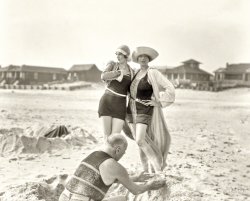
- Television Screen: 1950
- ... was still operating as a division of Unitronics Corp. of Long Island City. It probably disappeared the following year when Unitronics ... Posted by Dave - 09/16/2013 - 9:26am -
![Television Screen: 1950 July 12, 1950. "Hilda Kassell, East 53rd Street, New York City. Father reading newspaper, two children viewing television." The test-pattern tone is especially hypnotic this morning. Photo by Gottscho-Schleisner. View full size.
Multiple photosOther Gottscho-Schleisner photos relating to Hilda Kassell can be found online. There's one from about this same time showing her nursing her baby in front of this window, one from 1948 of what I would presume was her former residence at 50 East 10th Street, and an undated interior view of what may be her country house in Croton, New York. As there also are some references to photos by her, my best guess is that she worked for Gottscho-Schleisner or at least was associated with the company in some way. Hence their interest in her domestic life.
[Hilda Kassell was the designer whose business commissioned these photos. The people in them are models; the grander homes are those of her clients. -Dave]
Test Pattern IndianWe got our first TV in 1951 when I was 3 or 4 years old. I remember spending a lot of time staring at the Test Pattern Indian, and even at that early age wondering what the hell an Indian was doing in our TV, and when was he going to DO something. Maybe I really WAS hypnotized by the tone.
I Would Title This "Waiting for Howdy Doody"
It's all relativeCompared to nothing-zip-nada, a test pattern was interesting, if only because it indicated that the set was ready to erupt into entertainment when programming began (usually, late afternoon). And it was our technological friend, enabling the painstaking setting of horizontal and vertical hold, contrast, brightness, and whatever quality brings about absence of "snow," all before Buffalo Bob and Howdy appeared.
Did everyonehave a ship and brass baby shoes on top of the TV in the early 50's? I know we did.
Good QuestionWonder why the Indian head shot was used. It seems fairly universal, but why?
[A story about the original artwork and its survival is here. -tterrace]
Thanks, wonder why the fellow in '38 made that choice. Just because? Line definition quality? Thanks again.
Attention SpanAnd so it begins. The dumbing down of our children.
There really is nothing on TVIn this case, not only are the kids staring at a test pattern, they're staring at a fuzzy test pattern. At first I thought this was because WJZ is a Baltimore station, but in 1950, it was the ABC flagship station in New York.
Blank StaresThere's nothing quite like pretending to read the morning paper while the kids pretend to watch TV.
$419.95Looks like a Zenith, Lexington model without cabinet doors. Cost is four weeks pay for the average factory worker in 1950.
[It's an Olympic. -tterrace]
Olympic Radio & Televisionwas a trademark of Hamilton Radio Corp., established NYC 1941. Hamilton purchased the Olympic trademark from American Bosch Radio the same year. In 1956 Olympic Radio & Television was still operating as a division of Unitronics Corp. of Long Island City. It probably disappeared the following year when Unitronics was absorbed by Siegler, which then merged with Lear Inc.
Step UpOlympic was a recognized radio brand in the 1960s. Its TV line was strictly promotional. The attached ad shows a Radio/TV/Phono combo that probably sold in the $300-$400 price range. A comparable Magnavox unit sold for 2 to 3 times as much.
Sitting that CloseI was a child in the late 1960s. Whenever I would watch television my parents always supervised me because they wanted to ensure that I didn't sit too close to the set. They were convinced sitting too close to the television would cause me to develope leukemia or it would ruin my eyesight.
The first thought I had, when I looked at this photograph was the sound of my mother's voice "Don't sit so close to the TV!"
By the time I was 16 years old, I did have to start wearing glasses which gave my parents an "I told you so." moment. They were convinced that my lazy eye was a result of sitting too close to the tv when I watched Captain Kangaroo as a four year old.
The Ultimate Home Theatre!It's got both a small screen AND a big screen (for Dad to hide behind)!
Subway foldDad - or the model playing dad - is probably a regular subway rider. That's the NY subway fold that I learned from my father. When you're on a crowded train, there isn't room to open the paper all the way. So you fold the pages in half lengthwise.
PatternI hated daytime TV in the '50s. You'd be home sick from school and all that was on would be soaps and Queen for a Day.
You'd be lying there bored to death with onions that your Mom put in your socks, I have no idea what they were supposed to cure but Mom must have known.
(The Gallery, Gottscho-Schleisner, Kids, NYC, TV)](https://www.shorpy.com/files/images/SHORPY_5a19812u.thumbnail.jpg)
- Toyland: 1951
- December 1, 1951. "Shopping center, Great Neck, Long Island, New York. Wanamaker's. Lathrop Douglass, architect." A toy display ... just shopping; people were more formal then. I grew up on Long Island and 1951 I had just turned six. My family didn't go to Great Neck, ... Posted by Dave - 12/20/2013 - 12:28pm -
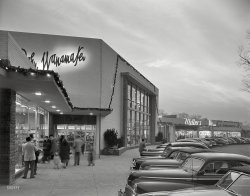
- Little House: 1925
- ... It is modeled on the John Howard Payne house on Long Island, which inspired Payne to write his famous song, "Home, Sweet ... Posted by Dave - 07/23/2012 - 3:40pm -
![Little House: 1925 May 16, 1925. Washington, D.C. "Mrs. Herbert Hoover and Mrs. James Ford at Girl Scouts' Little House," a cottage that served at different locations as model home and scouting headquarters. National Photo Company. View full size.
Can we get just one smile here?None of these girl scouts seem to be having fun.
The girl in the doorway particularly seems to be thinking about how she could have been watching one of those new talkies, or listening to Marian Anderson, or Fred Waring on the phonograph -- anything other hanging around that kitchen.
[There'd be a bit of a wait for talkies. - Dave]
More "Little Houses"Our circa 1825 Cape Cod homestead has been known locally as the "little house." When our local post office was run by local people, "little house" was part of our postal address.
Herbert, Herbert!At this time Grace Coolidge was first lady. Lou Hoover was the wife of Secretary of Commerce Herbert Hoover.
[Wups. Fixed! - Dave]
Half-bakedI love the expression on Oven Girl's face. "Whoa. This totally didn't come out the way it was supposed to!"
Stanley Ipkiss!I am apparently not well. Even before going to full size, the Mrs.Hoover had me thinking of Jim Carrey from "The Mask." Maybe it's the hat.
The girl in the doorwayHer facial expression seems to read, "Why am I here? At all!?" Maybe I'm reading too much into it, but that's about the unhappiest expression I've ever seen on the face of a child in an old photograph except for a few who were sitting on some department store Santa Claus's lap.
However, her mood can be improved 100% by colorizing the photo. (snicker)
UnbakedSince she's holding the pan bare-handed, I suspect she's putting the food INTO the oven, not taking it out. Apparently it required some pretty close supervision, judging by the way she's being hovered over.
UniformityWithout the telltale GS on the collar, I would never have figured out that Mrs. H. and the girls are ostensibly wearing the same outfit.
Will ya look at that!The teakettle is Polarware, made in my home town of Sheboygan Wis.
Better Homes Week
Washington Post, May 17, 1925
Mrs. Coolidge Visits Scouts' Little House
The interest of the White House was enlisted in the Better Homes week yesterday when Mrs. Calvin Coolidge visited the Girl Scouts' Little house at 1750 New York avenue northwest. The President's wife was received and conducted through the house by Mrs. Herbert Hoover, national president of the Girl Scouts, Inc., and Dr. James H. Ford, national director of the Better Homes in America movement.
The Girl Scouts have opened the Little house as an educational center for practical and applied home economics. It is modeled on the John Howard Payne house on Long Island, which inspired Payne to write his famous song, "Home, Sweet Home."
(The Gallery, D.C., Kitchens etc., Natl Photo)](https://www.shorpy.com/files/images/27041u.thumbnail.jpg)
- Airship: 1915
- New York, March 22, 1915. "Navy dirigible, Long Island." 5x7 glass negative, George Grantham Bain Collection. View full ... Posted by Dave - 09/13/2011 - 12:35pm -
![Airship: 1915 New York, March 22, 1915. "Navy dirigible, Long Island." 5x7 glass negative, George Grantham Bain Collection. View full size.
HighI like the little guard house on top of the hangar.
Heave ho!This picture really illustrates the size of the ground crews needed to manhandle these things around. Sort of like trying to deal with a huge drunken elephant on a unicycle.
Re: Pop QuizAt the Tillamook Air Museum in Tillamook, Oregon the building is called either a Blimp Hanger or an Airship Shed.
http://www.tillamookair.com
[Not quite. Next guess? - Dave]
Re: Re: Pop QuizStraight from my son in fifth grade: Aircraft are kept in a hangar. Not a "hanger."
[Sonny gets a gold star. Thank you! - Dave]
RockawayI thought the Rockaway Naval Air Station was founded in 1917, unless I have the location wrong.
Pop QuizWhat do we call the large structure where blimps and other aircraft are kept? (Hint: Not a "hanger," which is where you'd put a sweater, not an airplane.)
Blimp MemoriesI grew up in Akron, the home of the Goodyear blimps. I used to see the crews muscling the blimps in and out of the huge blimp hangars there. I toured one of the hangars on a grade school field trip. The thing that impressed my young mind the most was the tour guide telling us that it would sometimes rain inside the hangar on a sunny day, because rain clouds would get trapped inside the hangar.
I was in Akron recently and saw that one hangar is still there.
Not a Dirigible, not 1915My suspicions are confirmed by some brief online research. Dirigibles (rigid airships) are easily recognized by their "facets" - the skin is stretched across internal framing whose outline shows through. Blimps are inflated, and hence much rounder.
["Dirigible" does not, strictly speaking, mean "rigid airship" -- the current usage is a mistaken notion resulting from confusion over the similarity of the words "rigid" and "dirigible," which means "steerable." Ninety years ago, people correctly used the word "dirigible" to mean "steerable airship," whether or not the airship was rigid. The use of the word "dirigible" in the caption for this photo -- a caption written in 1915 -- has nothing to say about whether the airship has a rigid frame or not. - Dave]
Future Floyd Bennett NASHaving grown up in these parts, my educated guess is that we're looking at the future Floyd Bennett Naval Air Station, which operated until the middle 1960s or so. The multi-story building in the distance looks a little familiar. It might've survived until the 1950s.
The C-4 at NAS Rockaway?This looks a lot like the C-4, which operated out of NAS Rockaway.
However, NAS Rockaway wasn't built until (I believe) 1917
Here's some photos of it, including a shot of their blimp hangar. Note the same doors, and the cupola on the roof.
http://www.farrockaway.com/carol/morprockawayairhistory.html
Here's an image of the C-4 herself.
http://www.oocities.org/fort_tilden/c4-1.jpg
(The Gallery, G.G. Bain, NYC, Zeppelins & Blimps)](https://www.shorpy.com/files/images/28432u1.thumbnail.jpg)
- Levittown: 1958
- ... surprise! To one who had only seen aerial shots of the Long Island Levittown when it was a brand new scar on the landscape, this shot ... Posted by Dave - 11/23/2016 - 10:24pm -
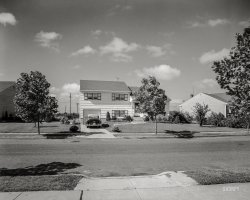
- Longacre Square: 1911
- ... ad seen here for the promised beach paradise of Tangier on Long Island. This development was the brainchild of one Frederick J. Quinby, ... something like a second Atlantic City growing out on Long Island's beaches. But alas, after the building of a single small hotel it ... Posted by Dave - 01/21/2019 - 1:41pm -
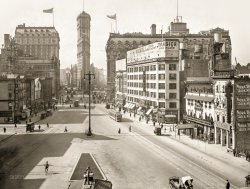
- American Doll: 1936
- ... windows to let in the light. Any NY'ers out there - think Long Island City, and it's abundance of factories and manufacturing plants.
... Posted by Dave - 02/26/2013 - 4:50pm -
![American Doll: 1936 1936. "Mount Holyoke, Mass. Paragon Rubber Co. and American Character Doll. Building rubber doll moulds." Photo by Lewis Hine, who seems to have moved on to bigger things once he was done snapping newsies. View full size.
Paragon, ACDCWhen it went out of business in 1989, Paragon Rubber Co. was located at 150 Pleasant St in Easthampton, just northwest of the town of Mt. Holyoke. American Character Doll Co. (known by its multiple-meaning acronym ACDC) apparently went out of business in 1989.
Not what comes to mindwhen you think of a Toymaker.
Big WindowsMost manufacturing plants always seemed to have a large amount of big windows to let in the light. Any NY'ers out there - think Long Island City, and it's abundance of factories and manufacturing plants.
One of the reasons (I believe) that plant owners did this was to save on electricity. I see the one light bulb hanging down. I am sure there were more but not too many.
[When most of these plants were built, electricity was not an option. - Dave]
HunksThere has been criticism of the tag "Pretty Girls" used with some pictures at Shorpy. Perhaps this example is #1 for the tag "Hunks"? As @Vintagestvs says - not your picture of a toymaker.
[The tag is called Handsome Rakes. - Dave]
LookalikeWow does he ever look like Chef Bobby Flay! Well except for those muscles. That file sure must give him a workout.
Humble requestThis man should definitely be among the ranks of the Handsome Rakes!
Ah, Shall I Say It?He's a "leg" man! What a HUNK!
I'll take two... dolls, of course!
Wow, what an amazing composition. This is a variation on one of Hine's most famous photos, of the powerhouse mechanic (1920). Like that one, this photo is as much a study of the human form as a snapshot of the American factory worker. I love a good juxtaposition, and this photo has it -- between the muscled upper torso of the craftsman and the doll legs he's working on. The light is also beautiful in this shot.
The precursorto inflatables.
Body builderThose must have been some tough dolls, to have helped him develop big muscles like that.
(The Gallery, Factories, Handsome Rakes, Lewis Hine)](https://www.shorpy.com/files/images/SHORPY_7494458622.thumbnail.jpg)
- Machine Shop: 1953
- ... 17, 1953. "F&R Machine Works, 44-14 Astoria Blvd., Long Island City, N.Y. General view from balcony. C.M. Johnson, client." Busy ... Posted by Dave - 08/17/2014 - 12:14pm -
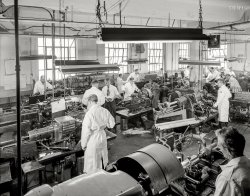
- Liberty Mutual: 1963
- ... Mutual Life Insurance Co., 444 Merrick Road, Lynbrook, Long Island. First floor, south wall." Bathed in the flattering glow of the ... Posted by Dave - 11/10/2015 - 5:52pm -
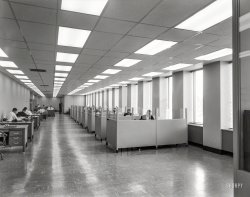
- Nuisances Prohibited: 1903
- Long Island circa 1903. "The Bowery -- Rockaway, New York." 8x10 inch dry plate ... Posted by Dave - 05/18/2014 - 12:34am -
![Nuisances Prohibited: 1903 Long Island circa 1903. "The Bowery -- Rockaway, New York." 8x10 inch dry plate glass negative, Detroit Publishing Company. View full size.
I wish I were BIGI wonder if the boys on the left realize the danger they may be in; that machine they are hanging around could be the Zoltan machine that turned David Moscow into Tom Hanks.
Hmmph.I guess that leaves me out.
Danger aboveThat ladder (if that's what it is) on the roof of the verandah at right looks a bit dangerous if it decided to slide off.
A nuisance, who me?Google "COMMIT NO NUISANCE." This was an expression from the olden days. A common sight back then to see it posted on walls, poles, bill boards, etc.
Spinoff jobsBack in the day there were people whose jobs it was to operate elevators, and yes, to operate weight scales once you stepped on them!
He's Gone Electric?What are the wires on the white stand in the right foreground. Can't tell if the gent staffing it is speaking into a device or holding a drink. The sign below says "Press the button . . . [blocked view]". Maybe that's what it is, but what is it?
[Looks like it probably says, "Press the button have your fortune told." - tterrace]
Where in RockawayI Lived in Far Rockaway from 1964 till 1969, does any one have any idea where this area was, there was nothing left of it even in 1964. There was a small amusement park on Beach 90th street with a Roller Coaster called the Atom Smasher. The amusement park was thrown down for housing in the 90's I believe.
Learn New WordsThe device with the wires looks very like an induction coil, much loved by quack doctors and malevolent small boys, with some kind of meter behind to add to the effect. Hold the handles, press the button - and impress your companions with your new vocabulary.
Rockaway PlaylandAs a kid in the fifties, my parents would drive over there. Then it was fairly large and competed with Rye Playland, Conney Island, and Palisades Park.
(The Gallery, DPC)](https://www.shorpy.com/files/images/SHORPY_4a11259a.thumbnail.jpg)
- Park Forest: 1954
- ... Not dead yet. As someone who commuted daily on the Long Island Rail Road from 1997 to 2009, and still rides it on occasion when I ... Posted by Dave - 08/03/2013 - 10:43am -
![Park Forest: 1954 July 1954. "Commuters on platform after getting off train. Park Forest, Illinois." Photo by Bob Sandberg for Look magazine. View full size.
Everyone dressed so much better!We might be more comfortable today but every one is a slob today compared to a few decades ago.
[They were thinner, too. - Dave]
White SoxThe Chicago White Sox are finally featured in Shorpy. Yes!
The CWS were in third place from July through the end of the season, behind NYY, and CLE who took the AL pennant.
Suits? Not dead yet.As someone who commuted daily on the Long Island Rail Road from 1997 to 2009, and still rides it on occasion when I have a work assignment in the city, I can say that men's suits are very much alive and well on commuter railroads today. There's probably no other public place where you'll find as many suit-wearing men. "Business casual" is a concept that doesn't quite live up to the hype.
Get rid of the hats, update the haircuts a bit, and add some laptop bags and cellphones, and this picture could almost be taken at a commuter rail station today. About the only real difference is that the percentage of women might be slightly higher, and depending on the station there probably would be more racial diversity.
Speaking of hats, there's the urban legend that most men wore hats until a bareheaded JFK at his 1961 inauguration suddenly made them unfashionable. Yet in this picture, taken more than six years earlier, about two-thirds of the men are hatless.
"If the picture was taken in the early evening, I believe it is possible that the early baseball scores and the stock market results for the same day might be included in the late editions of the papers."
This picture is definitely from the early evening, as you can tell by the shadows that the sun is low in the sky, and newspapers back then often had multiple editions and reported news in a very timely manner.
By the way, there is and was no Park Forest station on the Illinois Central/METRA line. Two stations, Lincoln Highway and Matteson, serve the town. I believe this is Matteson because if it were Lincoln Highway we'd see the thoroughfare of the same name in the background.
End of the lineThis is just about as far as you could go on the Illinois Central (now Metra) electrified trackage southbound out of Chicago. About an hour's ride.
A pretty hot trip in July on those 1920's vintage cars - they were still around when I rode the IC to work in the early '70's. But still more comfortable than the Rock Island's old "Capone cars" in which I logged a lot of miles, too.
Thursday, July 22nd?From what I can see of the legible newspaper headlines, there's a reference to ending a filibuster (there was a filibuster of an Atomic Energy bill that began on July 21st and ended at about 1:30 a.m. on July 23rd), a stock surge (the DJIA posted one of its largest gains of the month on July 22nd) and something about the White Sox that, in my experience of reading baseball headlines, seems like a result of an extra inning game " . . . White Sox in . . ." (the White Sox dropped the opener of a doubleheader that day to the Yankees in 10 innings). If the picture was taken in the early evening, I believe it is possible that the early baseball scores and the stock market results for the same day might be included in the late editions of the papers.
Straw boater on the rightRight out of the 20's, obsolete even in that day! Very snazzy!
The one woman...Looking at the camera holding the newspaper and jacket looks exactly like my Grandmother did back then. She did live in Olympia Gardens (a then very new development in Chicago Heights).
I am trying to find more pictures of my Grandmother from that time but one of my siblings has them put away (and lives across the country). This would be wonderful if it turns out to be her. It is so wonderful to go back in time on a site like this. Thank you for having it as there are many history buffs out there who appreciate these older photographs.
(The Gallery, Chicago, LOOK, Railroads)](https://www.shorpy.com/files/images/SHORPY_19943u.thumbnail.jpg)
- Strolling Through the Park: 1907
- ... Mowers' My father was the chief gardener of a Long Island NY estate in the '40s and I remember the stable had some old ... Posted by Dave - 12/19/2012 - 11:26am -
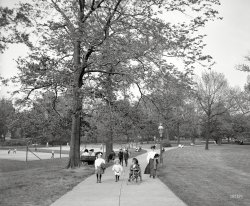
- Hazel Reiber: 1913
- Long Beach, Long Island, N.Y., circa 1913. "Hazel Reiber." Who was evidently enough of a ... Posted by Dave - 08/19/2012 - 4:57pm -
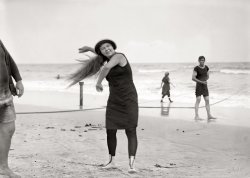
- Easier Living: 1951
- October 12, 1951. Great Neck, Long Island, N.Y. "Statton Modern at John Wanamaker. Russel Wright bedroom ... Posted by Dave - 12/26/2013 - 5:30pm -
![Easier Living: 1951 October 12, 1951. Great Neck, Long Island, N.Y. "Statton Modern at John Wanamaker. Russel Wright bedroom group. Auerbach Agency, client." Large-format acetate negative by Gottscho-Schleisner. View full size.
Travelodge, Version 1.0B Tests of this Beta version indicated strong user demand for matching, floral-print bedspreads and curtains.
Left bed is widerI count four and a half squares of bedspread/comforter crossing the left bed and barely four squares on the right one. How's that for precise measurement?
Peaceable KingdomRousseau's 'Peaceable Kingdom' seems an odd choice of artwork for the wall of such a modern, trendy room. AND it's such a small print, too. It happens to be a favorite of mine, but I would have thought something more contemporary would have been the preferred choice for a model room. But who knows what Wanamaker's decorator had in mind?
Next ExitThis example of a room will be the prime design of all the forthcoming motel rooms in North America.
All that's missing1. A USB charging port built into the base of the lamp.
2. An antimicrobial-coated remote control.
3. A table card with the Wi-fi instructions, and another with the phone number of the nearest pizza joint.
Yoo-hooRob? Laura?
Not a Hotel RoomWanamaker's was a chain of department stores. I assume even though it looks like it could be any 50's motel it is a model bedroom on a sales floor.
War on men"Hers" and "his" beds?
His and Hers?It looks to me that the left side is about a foot wider than the right side.
Optical illusion?Doesn't the left twin bed look wider than the right?
That saidWhy does the headboard fit the two mattresses perfectly? Was this a precursor to the king? I still don't understand the California king but I'm from the south.
ChintzyGenerally I love Russel Wright's ideas. Most everything in this room is appealing. But the chintz finish on the bedspreads is everything people criticize about mid-cent decor. It looks cold and stiff.
Horny?Not only is that piece of art out of scale, it is also terribly off-centered. My question is , is it suposed to be symbolic of the person sleeping below it? Horny
["The Peaceable Kingdom" by Edward Hicks. -tterrace]
(The Gallery, Gottscho-Schleisner, Stores & Markets)](https://www.shorpy.com/files/images/SHORPY_5a17221u.thumbnail.jpg)























